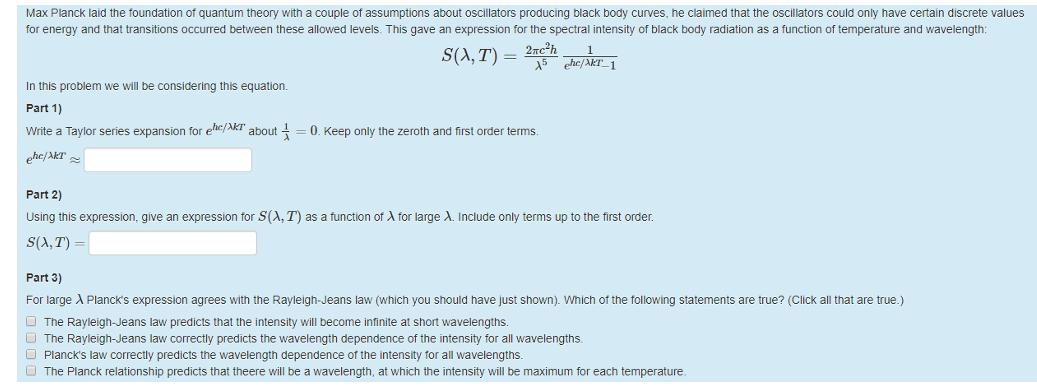Answered step by step
Verified Expert Solution
Question
1 Approved Answer
Max Planck laid the foundation of quantum theory with a couple of assumptions about oscillators producing black body curves, he claimed that the oscillators

Max Planck laid the foundation of quantum theory with a couple of assumptions about oscillators producing black body curves, he claimed that the oscillators could only have certain discrete values for energy and that transitions occurred between these allowed levels. This gave an expression for the spectral intensity of black body radiation as a function of temperature and wavelength: S(A, T) = 2h ehe/AKT 1 In this problem we will be considering this equation. Part 1) Write a Taylor series expansion for ehe/AKT about = 0. Keep only the zeroth and first order terms. ehe/AKT Part 2) Using this expression, give an expression for S(X, T) as a function of A for large X. Include only terms up to the first order. S(X,T) = Part 3) For large X Planck's expression agrees with the Rayleigh-Jeans law (which you should have just shown). Which of the following statements are true? (Click all that are true.) The Rayleigh-Jeans law predicts that the intensity will become infinite at short wavelengths. The Rayleigh-Jeans law correctly predicts the wavelength dependence of the intensity for all wavelengths. Planck's law correctly predicts the wavelength dependence of the intensity for all wavelengths. The Planck relationship predicts that theere will be a wavelength, at which the intensity will be maximum for each temperature.
Step by Step Solution
★★★★★
3.43 Rating (153 Votes )
There are 3 Steps involved in it
Step: 1

Get Instant Access to Expert-Tailored Solutions
See step-by-step solutions with expert insights and AI powered tools for academic success
Step: 2

Step: 3

Ace Your Homework with AI
Get the answers you need in no time with our AI-driven, step-by-step assistance
Get Started


